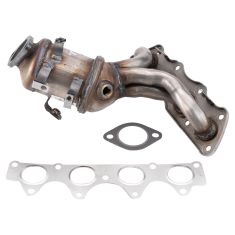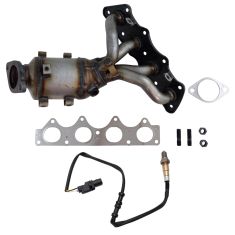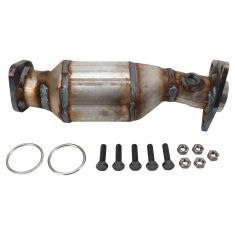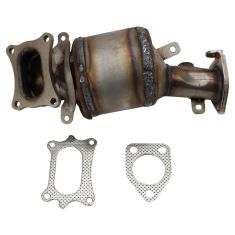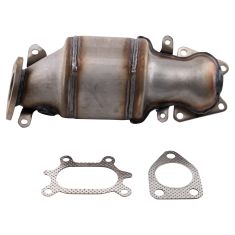Catalytic Converter - Direct Fit
-
-
- Air Deflectors & Valance Panels
- Battery Trays & Related
- Body Panels
- Bumpers & Related - Front & Rear
- Convertible Tops, Soft Tops, & Parts
- Decal & Stripe Kits
- Emblems & Nameplates
- Engine Compartment Trim
- Frame Parts & Bushings
- Fuel Door Parts
- Fuel Tank Filler Neck
- Grille
- Header Panel
- Hood & Hatch Lift Supports
- Hood Latch & Catch Brackets
- Hood Release Cable
- Jack Pads
- Radiator Supports
- Rust Repair Panels
- Splash Shields & Fender Liners
- Tailgate Cables
- Tailgate Hinges & Related
- Weatherstripping
-
- Car Covers
- Exterior Lighting
- Exterior Parts & Accessories
- Exterior Safety & Security
- Exterior Storage
- Fender Flares
- License Plate Brackets & Frames
- Mud Flaps & Splash Guards
- Nerf Bars, Side Steps, Running Boards
- Radio Antenna
- Rain Deflectors
- Roll Bars, Light Bars, & Related
- Roof Rack
- Skid Plates
- Spare Tire Carriers & Related
- Spare Tire Covers
- Tire Care
- Tonneau Covers
- Tow Hooks & D-Shackles
- Towing Accessories
- Trailer Hitch & Components
-
- Accelerator Pedal Pad
- Auto Carpet
- Brake Pedal Pad
- Clutch Pedal Pad
- Console Parts
- Dash Pad Cover
- Dash Vents
- Floor Mats & Liners
- Horns & Horn Parts
- Interior Parts & Accessories
- Mirror - Interior Rear View
- Seat Cover and Sets
- Seat Heater Kits
- Seat Parts and Accessories
- Sun Visors & Related
- Trunk & Cargo Parts
-
- Accelerator Pedals & Sensors
- Alarms, Control Modules, & Remote Start
- Cruise Control Switch & Lever
- Electrical Parts
- Hazard Switch
- Ignition Key Lock Cylinder
- Ignition Switch
- Keyless Entry Remote & Related
- Neutral Safety Switch
- Parking Assist Cameras & Monitors
- Power Mirror Switch
- Power Seat Switches
- Power Window Switch
- Radio, Navigation, Entertainment
- Reverse Light Switch
- Trunk Release & Lock Solenoids
- Turn Signal Switches and Levers
- Windshield Wiper Switch
-
- Idler Arm
- Pitman Arm
- Power Steering Hoses
- Power Steering Oil Cooler
- Power Steering Pressure Sensor
- Power Steering Pump
- Power Steering Pump Cooling Fan
- Power Steering Pump Pulley
- Power Steering Pump Reservoir
- Steering Dampers
- Steering Knuckles and Spindles
- Steering Rack and Gear Boxes
- Steering Shafts & Couplers
- Steering Wheels & Column Parts
- Tie Rods & Adjusting Sleeves
-
-
-
-
712
72
10
10
-
Notify When Available
Replaces Chevrolet GMC Buick Cadillac Front Right Catalytic Converter TRQ EXA46116
Brand: TRQ - EXA46116$309.95Save 30%List $442.95 Save $133.00Brand: TRQ - EXA46116$309.95Save 30%List $442.95 Save $133.00 -
Notify When Available
Replaces Chevrolet Buick Front Before Catalytic Converter Catalytic Converter TRQ EXA46124
Brand: TRQ - EXA46124$260.95Save 34%List $393.95 Save $133.00Brand: TRQ - EXA46124$260.95Save 34%List $393.95 Save $133.00 -
Notify When Available
Replaces Hyundai Kia Front Exhaust Manifold Catalytic Converter Assembly TRQ EXA63627
Brand: TRQ - EXA63627$321.95Save 35%List $493.95 Save $172.00Brand: TRQ - EXA63627$321.95Save 35%List $493.95 Save $172.00 -
Notify When Available
Replaces Hyundai Kia Exhaust Manifold Catalytic Converter Assembly DIY Solutions EXH00209
Brand: DIY Solutions - EXH00209$429.95Save 30%List $615.95 Save $186.00Brand: DIY Solutions - EXH00209$429.95Save 30%List $615.95 Save $186.00 -
Notify When Available
Replaces Subaru Front Exhaust Manifold Catalytic Converter Assembly TRQ EXA46134
Brand: TRQ - EXA46134$295.95Save 34%List $446.95 Save $151.00Brand: TRQ - EXA46134$295.95Save 34%List $446.95 Save $151.00 -
Notify When Available$186.95Save 33%List $279.95 Save $93.00Brand: TRQ - EXA46114$186.95Save 33%List $279.95 Save $93.00
-
Notify When Available$285.95Save 34%List $430.95 Save $145.00Brand: TRQ - EXA46127$285.95Save 34%List $430.95 Save $145.00
-
Notify When Available$200.95Save 34%List $302.95 Save $102.00Brand: TRQ - EXA46126$200.95Save 34%List $302.95 Save $102.00
-
Notify When Available$142.95Save 29%List $199.95 Save $57.00
Replaces Exhaust Manifold TRQ EXA52311
Brand: TRQ - EXA52311$142.95Save 29%List $199.95 Save $57.00 -
Notify When Available
Replaces Honda Acura Saturn Front Exhaust Manifold Catalytic Converter Assembly TRQ EXA46125
Brand: TRQ - EXA46125$183.95Save 34%List $276.95 Save $93.00Brand: TRQ - EXA46125$183.95Save 34%List $276.95 Save $93.00
loading...
Choose the Make of Your Vehicle


